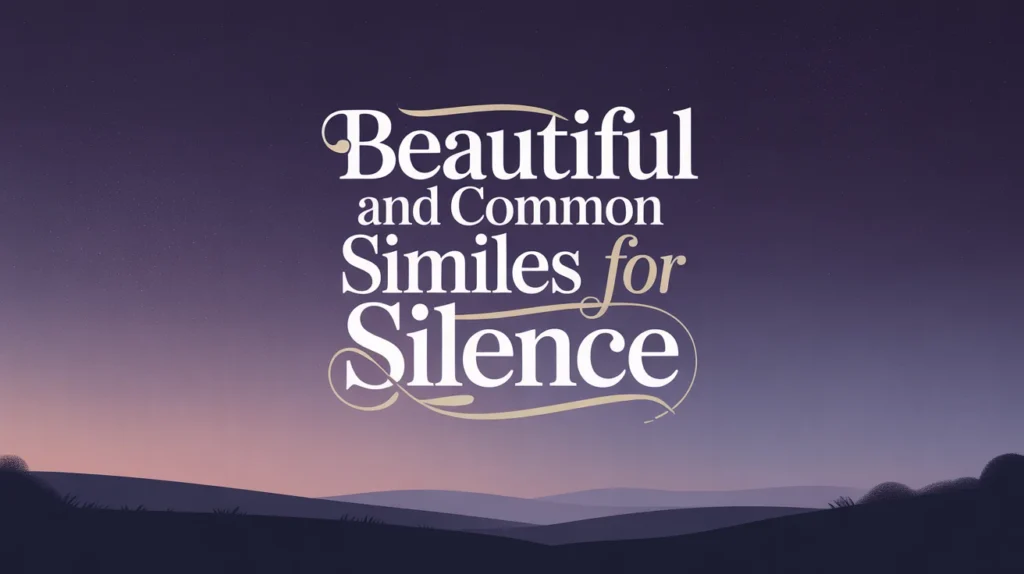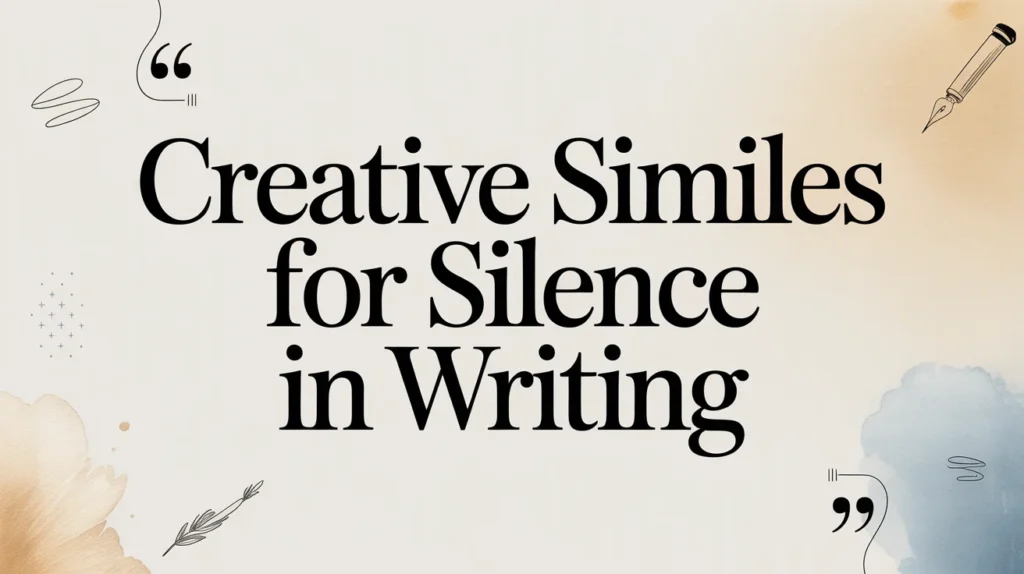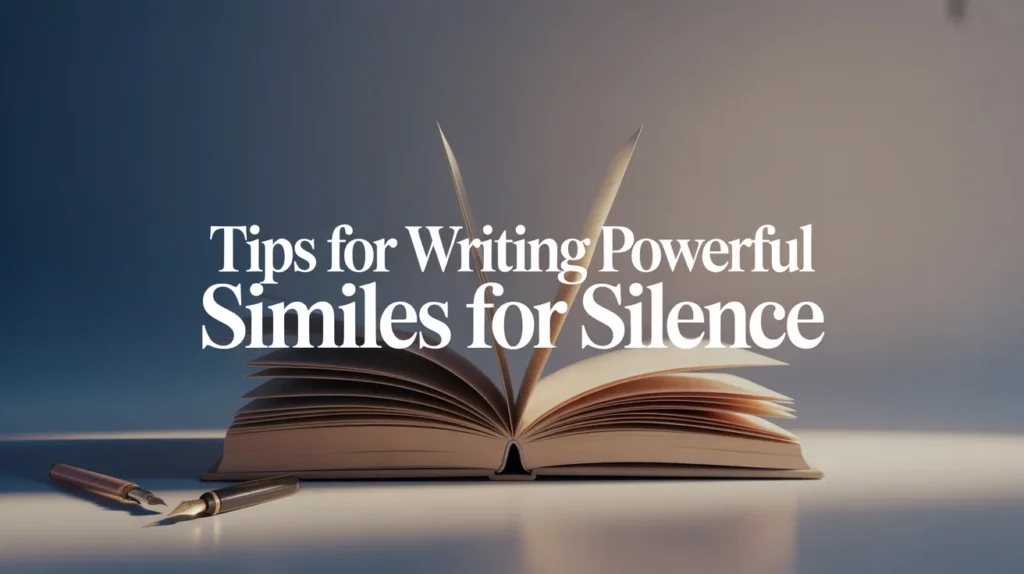Silence — a word that carries more emotion than most sounds ever could. It can be peaceful, awkward, sacred, or even haunting. When writers, poets, or speakers want to describe silence, they often turn to similes — vivid comparisons that make the invisible feel tangible.
If you’ve ever wondered how to capture the essence of stillness in your writing, then exploring similes for silence is the perfect place to start. From “as quiet as a whisper” to “silent as the grave,” these comparisons bring your scenes, emotions, and characters to life.
In this article, we’ll dive deep into the world of similes for silence, explaining their meanings, giving examples, and showing you how to use them effectively — whether you’re a writer, student, or content creator.
What Is a Simile and Why Use It for Silence?
Before exploring the beauty of silence in language, let’s first understand the foundation — what a simile is.
A simile is a figure of speech that compares two unlike things using the words “like” or “as.” It creates a vivid image in the reader’s mind, helping them understand an abstract concept through something familiar.
For example:
- “As silent as the stars” paints a picture of calm, cosmic quietness.
- “Like a graveyard at midnight” conveys an eerie, haunting stillness.
Why Similes Work for Silence
Silence is not something you can see or touch — it’s an experience. Similes help translate that experience into imagery, giving readers a way to feel silence through comparison.
Writers use similes for silence to:
- Create atmosphere (e.g., suspense, calm, mystery).
- Show emotional depth (peace, fear, sadness, reflection).
- Enhance poetic expression and flow.
- Add relatability by linking silence to common human experiences.
Beautiful and Common Similes for Silence

Here are some of the most expressive and popular similes for silence, organized by mood and tone.
SimileMeaning / MoodUsage ExampleAs silent as the graveDeep, eerie quietness“The room was as silent as the grave after the argument.”As quiet as a whisperGentle, soft silence“Her voice faded until the room was as quiet as a whisper.”As still as deathTotal absence of sound or movement“The forest was as still as death under the pale moon.”As silent as snow fallingPeaceful, calm quiet“Outside, the world was as silent as snow falling on the ground.”As quiet as a mouseTimid or cautious silence“He tiptoed across the room, as quiet as a mouse.”Silent as the starsCalm, distant silence“They sat beneath the night sky, silent as the stars above.”As silent as stoneUnmoving, lifeless silence“The statue stood as silent as stone in the corner.”As silent as a shadowMysterious, unnoticed quiet“He slipped into the alley as silent as a shadow.”As quiet as dawnPeaceful beginning silence“The village was as quiet as dawn, still waking from its dreams.”As silent as a candle flameFragile and delicate stillness“Her thoughts flickered, as silent as a candle flame in the dark.”
Poetic Similes for Silence
Poets often use silence to express emotion, mystery, or serenity. Here are a few poetic similes that add beauty and rhythm to writing:
- “As silent as a prayer in an empty church.”
- “Silent as the moon watching over sleeping seas.”
- “As still as a reflection in water.”
- “As quiet as forgotten dreams.”
- “Silent as snow covering the earth’s heartbeat.”
These comparisons turn silence into a living image, something the reader can see and feel rather than just understand intellectually.
Similes for Awkward or Tense Silence
Not all silences are peaceful. Sometimes, silence speaks louder than words — filled with tension, fear, or discomfort.
Here are similes that capture that kind of quiet:
- “As silent as a held breath.”
- “As quiet as a secret waiting to be told.”
- “Silent as a room full of unspoken words.”
- “As still as glass before it shatters.”
- “Silent as the calm before a storm.”
These expressions are ideal for storytelling, screenwriting, or dialogue, especially in moments of suspense, confrontation, or emotional distance.
Similes for Peaceful or Serene Silence
When silence represents calmness, reflection, or peace, these similes create that soothing mood:
- “As silent as morning mist.”
- “As quiet as the hush before sunrise.”
- “Silent as a garden after rain.”
- “As still as sleeping cats.”
- “As silent as petals falling.”
These similes work beautifully in nature writing, meditation blogs, or lyrical essays, where tranquility is the goal.
Creative Similes for Silence in Writing

If you want your descriptions to stand out, try creating original similes. Think about what silence feels like, not just what it sounds like.
Here’s how you can brainstorm unique similes for silence:
StepTechniqueExample1Think about what silence reminds you of“Like waiting for the stars to blink.”2Compare silence to slow movement“As silent as clouds drifting.”3Use sensory imagery“As quiet as dust settling on a shelf.”4Add emotion“Silent as regret buried deep inside.”5Use contrast“As silent as laughter that never came.”
These imaginative comparisons give your writing originality and emotional impact, perfect for stories, poetry, or essays.
Using Similes for Silence in Sentences
Here are examples showing how these similes fit naturally into writing:
- “The classroom grew as silent as a tomb after the teacher walked in.”
- “She listened, as quiet as a candle flame, her thoughts flickering softly.”
- “The night was as still as death, the only sound her own heartbeat.”
- “After his confession, the air turned silent as stone between them.”
- “He crept into the house as silent as a shadow, careful not to wake anyone.”
Each example shows silence being felt rather than simply described — a mark of powerful writing.
Why Similes for Silence Enhance Writing
Silence can be powerful, but writing it can be tricky. Similes give silence shape and soul, helping writers:
✅ Show emotion indirectly — instead of saying “He was nervous,” say “He stood as silent as a held breath.” ✅ Add mood and atmosphere — silence can be comforting or chilling depending on the simile used. ✅ Make scenes cinematic — readers can visualize and “hear” the silence. ✅ Create pacing — silence written through similes slows the rhythm, adding tension or calm.
Tips for Writing Powerful Similes for Silence

- Avoid clichés like “quiet as a mouse” unless they fit your tone.
- Match the simile’s mood to the scene — peaceful, eerie, or suspenseful.
- Use sensory language (sight, touch, emotion).
- Keep it natural — forced comparisons break immersion.
- Experiment with new ideas — silence can be soft, heavy, electric, or fragile.
✨ Pro Tip: Pair silence similes with strong verbs or emotional cues to deepen the impact. Example: “She waited, as silent as the moon, yet her eyes burned with stormlight.”
Table: Similes for Silence by Emotion
EmotionSimile ExamplesPeacefulAs silent as dawn, As quiet as clouds drifting, Silent as the starsTenseAs silent as a held breath, As quiet as fear, Silent as unspoken truthSadSilent as tears that never fall, As still as broken memoriesMysteriousAs silent as a shadow, As quiet as the unseen, Silent as a secretRomanticSilent as two hearts listening, As quiet as love unspoken
SEO Tips: Internal Linking Ideas
If you’re running a writing or literature blog, you can link this article internally to posts like:
- “Similes for Happiness”
- “Metaphors for Love”
- “How to Use Figurative Language in Creative Writing”
- “Examples of Personification in Poetry”
This improves SEO structure, user engagement, and dwell time, signaling Google that your site provides comprehensive literary resources.
FAQs About Similes for Silence
1. What does “as silent as the grave” mean?
It means complete, deathly silence — a deep quiet that feels eerie or lifeless. It’s often used in dark or serious scenes.
2. Can I use similes for silence in formal writing?
Yes, but use them carefully. In formal essays, stick to subtle similes like “as quiet as the early dawn” to maintain tone and professionalism.
3. What’s the difference between a simile and a metaphor for silence?
A simile uses “like” or “as” (e.g., “as silent as snow”), while a metaphor makes a direct comparison (e.g., “the silence was a blanket over the world”).
4. How can I make my similes sound original?
Avoid overused phrases and use imagery from nature, emotions, or sensory experiences. For example, “as silent as forgotten stars” is fresh and poetic.
5. Why is silence such a powerful theme in writing?
Because silence conveys emotion, reflection, and mystery without words. It allows readers to feel the weight of a moment, making the scene more powerful.
Conclusion: The Beauty of Expressing Silence
Silence is never just the absence of sound — it’s the presence of meaning. Whether it’s peace before dawn, fear before confession, or the comfort of shared quiet, silence speaks through emotion.
Using similes for silence allows you to give form to that emotion, helping readers experience it vividly. From “as silent as the grave” to “as quiet as falling snow,” these phrases transform ordinary moments into poetic expressions of stillness.
So next time you write — don’t just say it was quiet. Show it. Make silence come alive, and let your words whisper what the sound cannot.

Michael Trent is a professional editor and content strategist passionate about perfecting written communication. His articles focus on common writing mistakes, sentence flow, and modern grammar trends that every learner should know.

